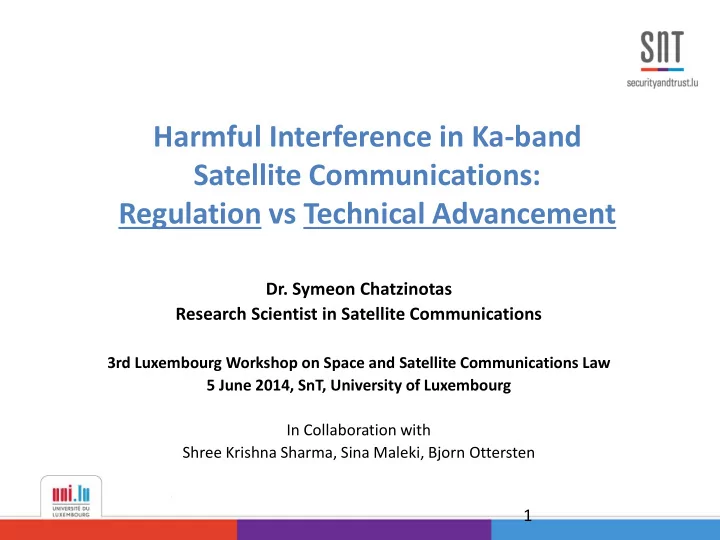

Harmful Interference in Ka-band Satellite Communications: Regulation vs Technical Advancement Dr. Symeon Chatzinotas Research Scientist in Satellite Communications 3rd Luxembourg Workshop on Space and Satellite Communications Law 5 June 2014, SnT, University of Luxembourg In Collaboration with Shree Krishna Sharma, Sina Maleki, Bjorn Ottersten 1
Outline • Motivation • Why Ka-band? – Considered system and frequency plan • Sources of possibly harmful interference – Scenarios A, B, C • Technical solutions – Cognitive Radio for SatComs • Regulatory Challenges • Conclusions 2
Current Regulatory Regime • Current status – Static frequency allocation – Spectrum Segmentation • Regulate using – Spectral Masks – Interference Limits • ITU-R Recommendations
Way Forward… • Temporal and spatial variations in the spectrum occupancy – Spectrum holes • How to exploit without affecting existing services? • Technical Advancement and/or Spectrum Regulation?
Spectral Coexistence • Primary - QoS guarantees – Priority on spectrum utilization – Allows coexistence • Secondary - No QoS guarantees – Opportunistic / on-demand access – Does not degrade primary QoS • Coprimary – First Come First Served – New services have to protect older Services 5
Digital Divide • EU Digital Agenda promises Broadband for All • 4G networks provide higher rates to fewer people • Ka-band broadband systems – Wide coverage/bandwidth – Flexible capacity allocation Illustration by BATS project 6
High-Level System Architecture Aspects Ka-band Broadband Interactive TTC High Throughput Satellite (HTS) At least one GSO satellite Multi-spot beam w/ frequency re- use GW1 Star topology network connecting anchor GWs and user terminals ISP1 Backbone FL: feeder uplink + user downlink Backbone ISP2 GW GW DVB-S2/Sx or similar air interface RL: user uplink + feeder downlink DVB-RCS2 or similar air interface NCC SCC NCC : Network Control Center SCC : Satellite Control Center ISP : Internet Service Provider TTC : Telemetry, Tracking & Control 7
Nominal frequency plan • Uplink/downlink: 5-times more spectrum FSS Exclusive BSS/FSS Shared FSS Shared FSS Shared allocation allocation allocation allocation User down link 17.3 17.7 18.7 18.8 19.7 20.2 GHz LHCP RHCP User up link 27.5 28.25 29.5 30.0 GHz LHCP RHCP FSS Exclusive FSS Shared allocation allocation 8
Nominal frequency plan • Uplink: 2-times more spectrum • Downlink: 5-times more spectrum FSS Exclusive FSS Shared FSS Shared FSS Shared allocation allocation allocation allocation User down link 19.7 20.2 GHz 18.7 18.8 17.3 17.7 LHCP RHCP User up link 28.9465 29.5 30.0 GHz 28.4465 LHCP RHCP FSS Exclusive Unccordinated FSS earth station allocation in countries adopting ECC/DEC/(05)01 (updated March 2013) 9
Scenario A Cognitive Radio GSO satellite downlink in the Ka-band 17.3-17.7 GHz Harmful interference: Secondary FSS Mitigate using technology • FSS cognitive satellite terminals reusing frequency bands of other BSS GSO feeder link systems also operating in this band • Support of satellite terminals on mobile platforms 10
Scenario B Cognitive Radio GSO satellite downlink in the Ka-band 17.7-19.7 GHz Harmful interference: Secondary FSS Mitigate using technology • FSS cognitive satellite terminals reusing frequency bands of FS links with priority protection • Support of satellite terminals on mobile platforms 11
Scenario C Cognitive Radio GSO satellite uplink in the Ka-band 27.5-29.5 GHz Harmful interference: Primary FS Mitigate using technology Respect interference limits • FSS cognitive satellite terminals reusing frequency bands of FS links with priority protection • Support of satellite terminals on mobile platforms 12
CoRaSat Vision and Objectives CoRaSat vision is a • Cognitive Radio Satellite Communications (CoRaSat) system – implementing flexible and smart spectrum usage to exploit unused or underused frequency resources assigned to satellite services as primary or secondary allocation . Primary'Link ! Incumbent Link Cogni&ve)Link ! Cognitive Link Primary' Incumbent Satellite Link Satellite'Link ! Incumbent Primary' Terrestrial Cogni&ve)) Terrestrial'Link ! Link Cognitive Satellite)Link ! Satellite Link CoRaSat aims at enabling its vision by • investigating, developing, and demonstrating Cognitive Radio techniques – relevant to Satellite Communications systems for dynamic spectrum sharing. providing guidelines for the definition of regulatory, standardization, and – technology frameworks for the exploitation of cognitive radio in support of the Digital Agenda for Europe.
− “ ” “ ” Cognitive Radio • Incumbent User: a (licensed) user who has higher priority or legacy rights on the usage of a specific part of the spectrum • Cognitive (or New Entrant) User: an (unlicensed) user who has a lower priority and is allowed to opportunistically use spectrum assigned to an incumbent user “ ” “ ” “ y” “c ” in such a way that it does not cause any unacceptable interference to “ ” incumbent users “ ” “ ” “ ”) “ ” “ ” 14
White Spaces • Unused Spectrum: – Time – Frequency ECC • How to detect, organize and allocate? – One of the most prominent solutions – Cognitive databases 15
Databases • Centralized information – Geographical data – Services – Policy, Regulation – Historical data – Radio • Location • Orientation • Power • Antenna 16
Regulatory Challenges • Regulations to facilitate sharing/trading – Spectral Databases – How to persuade national regulators to share? – Sensitive information=>Security concerns – Private sector can help: manage DBs, deploy sensors • Collaboration between national and international authorities – Terrestrial spectrum at national level, satellite at international – Cross-border coordination • Dynamic access to government/military exclusive spectrum – For secondary access – Instant release if needed e.g. public safety scenarios • Agreement in ITU-R level 17
Conclusions • Answer resides in the grey area • Depending on the considered coexistence scenario: – Technology could possibly enable the spectral coexistence under current regulations – Data sharing by/between national regulators needed to implement the technical solutions – Certain tasks allocated to private companies under proper supervision • Regulations should facilitate rather than obstruct technological evolution 18
Thank you! Questions & Discussion Contact: Symeon.chatzinotas@uni.lu http://www.uni.lu/snt/people/symeon_chatzinotas
Recommend
More recommend